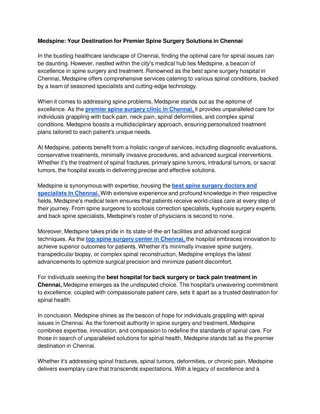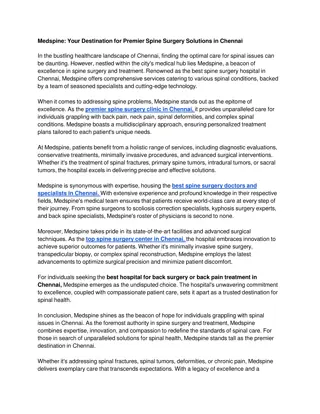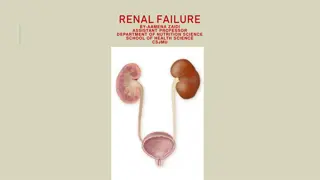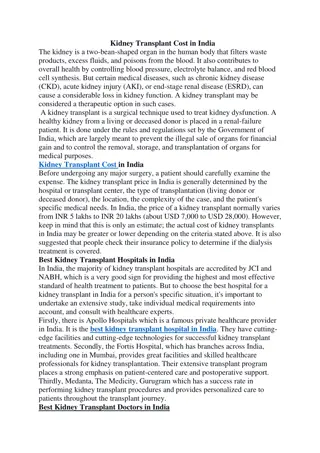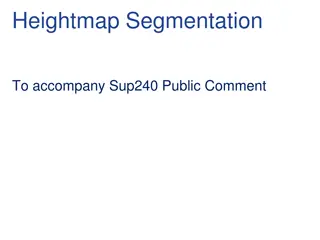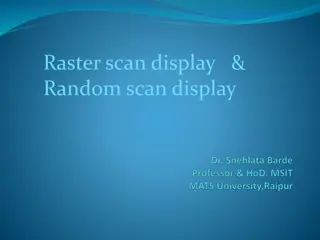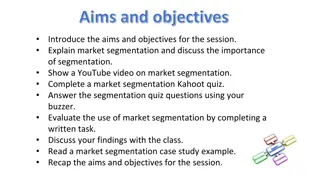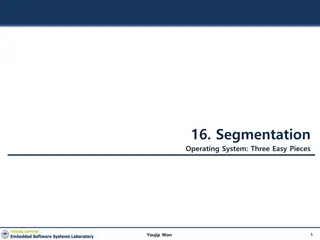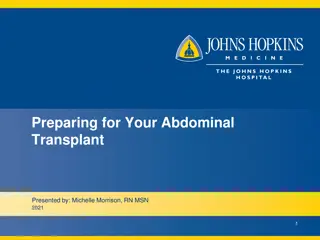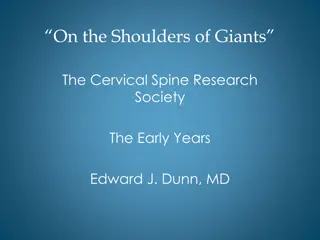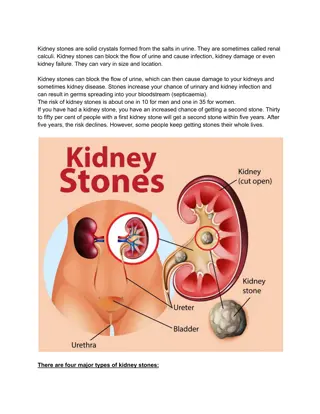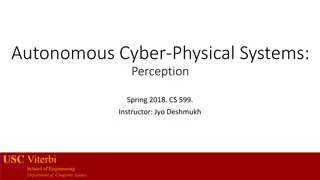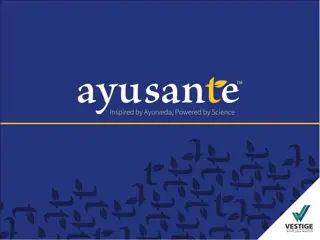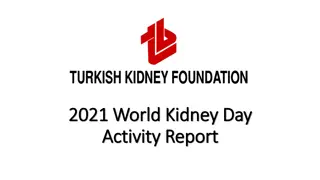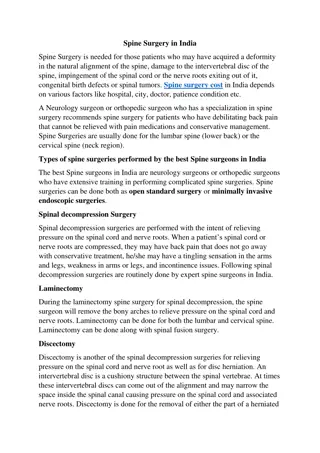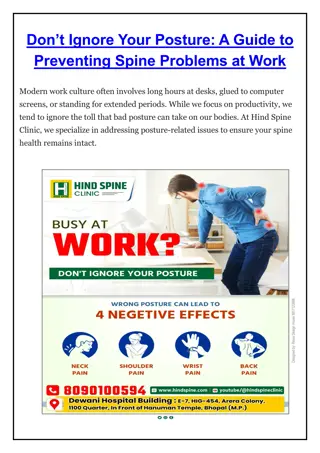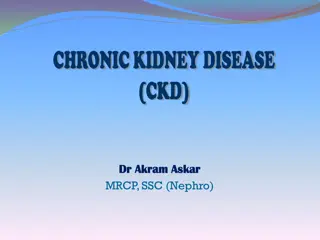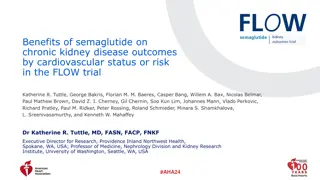Automatic Kidney Segmentation in CT Scan Series Using Spine Landmark and Soft Clustering
This project focuses on automating kidney segmentation in CT scan series by leveraging spine landmarks and soft clustering algorithms to better handle inhomogeneity in injured kidneys. The method involves extracting elliptical candidate regions and utilizing prior medical knowledge for accurate segmentation. By starting from the middle slice of CT scans and referencing previous kidney masks, the system enables automatic segmentation with enhanced efficiency.
Download Presentation

Please find below an Image/Link to download the presentation.
The content on the website is provided AS IS for your information and personal use only. It may not be sold, licensed, or shared on other websites without obtaining consent from the author.If you encounter any issues during the download, it is possible that the publisher has removed the file from their server.
You are allowed to download the files provided on this website for personal or commercial use, subject to the condition that they are used lawfully. All files are the property of their respective owners.
The content on the website is provided AS IS for your information and personal use only. It may not be sold, licensed, or shared on other websites without obtaining consent from the author.
E N D
Presentation Transcript
Automatic Kidney Segmentation in CT Scan Series
Main Ideas 1. Using spine as the landmark to locate the kidney, and some prior medical knowledge to extract a smaller elliptical candidate region. Choosing a soft clustering algorithm instead of dynamic thresholding or region growing to better deal with the inhomogeneity inside the injured kidneys. Starting from the middle slice of CT scan sets which always contains largest kidneys, and using the previous kidney mask as a reference to next one to enable automatic segmentation. 2. 3.
[1] Computer-Aided Kidney Segmentation on Abdominal CT Images, Daw-Tung Lin, et. al. Cavity Boundary Detection 1 1. 2. Discard pixels outside the abdominal boundary Find contours, fit ellipses for each contours, choose the ellipse which fit the cavity boundary best Candidate Region Extraction 2 1. 2. Allocate the spine landmarks. Use heuristics about the relative location to find the elliptical candidate regions for left and right kidneys. Spatial Constrained Kernelized Fuzzy C- means Clustering 3 Automatically Go Up and Down 4 X: (0.5l1, 0.56l2), (x0, y0): 0.28l1 to the spine Short axis: 0.4l1, Long axis: 0.6l2 Rotation angle: 60 degrees. [1]
Reference Paper: Zhang D Q, Chen S C. A novel kernelized fuzzy c-means algorithm with application in medical image segmentation[J]. Artificial intelligence in medicine, 2004, 32(1): 37- 50. Cavity Boundary Detection 1 1. 2. Discard pixels outside the abdominal boundary Find contours, fit ellipses for each contours, choose the ellipse which fit the cavity boundary best Fuzzy C-means Hard Clustering(K-Means) Candidate Region Extraction 2 1. 2. Allocate the spine landmarks. Use heuristics about the relative location to find the elliptical candidate regions for left and right kidneys. Clustering Method Spatial Constrained Kernelized Fuzzy C- means Clustering Soft Clustering(Fuzzy C-Means) 3 Automatically Go Up and Down 4
Cavity Boundary Detection 1 1. 2. Discard pixels outside the abdominal boundary Find contours, fit ellipses for each contours, choose the ellipse which fit the cavity boundary best Fuzzy C-means Input Data: Candidate Region Extraction 2 1. 2. Allocate the spine landmarks. Use heuristics about the relative location to find the elliptical candidate regions for left and right kidneys. Centroids: Partition Matrix: Spatial Constrained Kernelized Fuzzy C- means Clustering 3 Automatically Go Up and Down 4 n=16, p=2, c=2
Cavity Boundary Detection 1 1. 2. Discard pixels outside the abdominal boundary Find contours, fit ellipses for each contours, choose the ellipse which fit the cavity boundary best Fuzzy C-means For CT images of size N x M, each pixel is a data point. Candidate Region Extraction 2 1. 2. Allocate the spine landmarks. Use heuristics about the relative location to find the elliptical candidate regions for left and right kidneys. Spatial Constrained Kernelized Fuzzy C- means Clustering So the size of partition matrix U should be: N x M x C 3 Automatically Go Up and Down 4
Cavity Boundary Detection 1 1. 2. Discard pixels outside the abdominal boundary Find contours, fit ellipses for each contours, choose the ellipse which fit the cavity boundary best Fuzzy C-means Objective Function: Candidate Region Extraction 2 1. 2. Allocate the spine landmarks. Use heuristics about the relative location to find the elliptical candidate regions for left and right kidneys. Updating Rules: Spatial Constrained Kernelized Fuzzy C- means Clustering 3 Automatically Go Up and Down 4
Cavity Boundary Detection 1 1. 2. Discard pixels outside the abdominal boundary Find contours, fit ellipses for each contours, choose the ellipse which fit the cavity boundary best Kernelized Fuzzy C-means Mapping data points into feature space: Candidate Region Extraction 2 1. 2. Allocate the spine landmarks. Use heuristics about the relative location to find the elliptical candidate regions for left and right kidneys. Spatial Constrained Kernelized Fuzzy C- means Clustering 3 Automatically Go Up and Down 4
Cavity Boundary Detection 1 1. 2. Discard pixels outside the abdominal boundary Find contours, fit ellipses for each contours, choose the ellipse which fit the cavity boundary best Kernelized Fuzzy C-means with Spatial Constraints Candidate Region Extraction 2 1. 2. Allocate the spine landmarks. Use heuristics about the relative location to find the elliptical candidate regions for left and right kidneys. Update Rules: Spatial Constrained Kernelized Fuzzy C- means Clustering 3 Automatically Go Up and Down 4
Cavity Boundary Detection 1 1. 2. Discard pixels outside the abdominal boundary Find contours, fit ellipses for each contours, choose the ellipse which fit the cavity boundary best Kernelized Fuzzy C-means with Spatial Constraints Steps: Initiate the partition matrix U. Update the centroid V. Update the partition matrix U. Terminate when max(|U_old - U|) <= 10^-7. Candidate Region Extraction 2 1. 2. Allocate the spine landmarks. Use heuristics about the relative location to find the elliptical candidate regions for left and right kidneys. Spatial Constrained Kernelized Fuzzy C- means Clustering 3 Open then Choose the connected component which is large enough and closest to the spine and value larger than the 2nd cluster. Close then dilate to contain the surroundings. Get the rectangular boundary of the kidney mask. Automatically Go Up and Down 4
Cavity Boundary Detection 1 1. 2. Discard pixels outside the abdominal boundary Find contours, fit ellipses for each contours, choose the ellipse which fit the cavity boundary best 1. Perform SKFCM in the small rectangular region we get from the previous kidney. Candidate Region Extraction 2 2. Do the same operation as the first slice. (Note: if there s no eligible connected region, use the previous kidney as the mask). 1. 2. Allocate the spine landmarks. Use heuristics about the relative location to find the elliptical candidate regions for left and right kidneys. 3. Get the bounding rectangle of this kidney, check if its location & shape similar to the previous rect. If not, shrink the previous one by 10 pixels and use it. Spatial Constrained Kernelized Fuzzy C- means Clustering 3 4. For the last few slices, use the previous kidney as the mask and erode with a 3x3 kernel every slice. Automatically Go Up and Down 4


